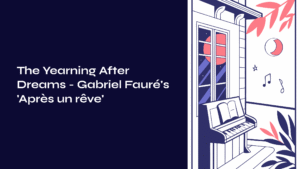Table of Contents

A Moment When Time Stood Still
The moment I sat at the piano, a scene from my childhood suddenly surfaced. An afternoon when sunlight slanted through the window, and I was enveloped in my mother’s gentle lullaby, surrendering to that peaceful drowsiness. I had no idea then how precious that moment was, nor that years later, a German composer would capture the very same emotion in musical notes.
Robert Schumann’s “Träumerei” is exactly that kind of piece. This small gem of a composition, whose German title means “dreaming” or “reverie,” has the power to momentarily suspend time for its listeners. In just over three minutes, we find ourselves floating between the innocence of childhood and the wistful longing that comes with adulthood.

1838: When Love and Longing Converged
Schumann composed “Kinderszenen” (Scenes from Childhood), Op. 15, in 1838, when he was 28 years old. At the time, he was preparing to marry Clara Wieck, but faced fierce opposition from Clara’s father, Friedrich Wieck. During this period of forced separation from his beloved, Schumann delved deep into his inner world, drawing forth memories of his own childhood.
The collection originally consisted of thirty small pieces, but Schumann selected only thirteen for publication. “Träumerei” serves as the seventh piece and the emotional centerpiece of the entire set. Interestingly, Schumann initially provided no titles for the individual pieces, calling them simply “Easy Pieces.” The evocative titles were added later as “delicate hints for execution and interpretation.”

The Architecture of Dreams in Three Breaths
“Träumerei” is written in F major, 6/8 time, following a ternary form. But rather than dwelling on technical details, let’s explore how this music touches our hearts.
First Section – The Dream Begins
The piece opens as quietly as awakening from deep sleep. The left hand’s gentle accompaniment evokes the rhythm of a lullaby, while the right hand’s melody seems to whisper in our ear. Though this melody spans just four measures, the emotional depth contained within is anything but simple. Small sighing intervals throughout add a poignant melancholy to the entire piece.
Second Section – Deepening the Dream
Beginning at measure 9, the middle section modulates to C major, deepening the emotional content. It’s as if we’re falling from one dream into an even deeper one. As the harmony grows more complex and the rhythm subtly shifts, fragments of childhood memories seem to drift past. Here, performers can use freely flowing tempo changes to enhance the piece’s dreamlike atmosphere.
Third Section – Awakening from the Dream
From measure 17, the opening theme returns, but now it sounds more mature and profound than before. Like someone reluctant to let go of a dream’s lingering effects, the piece fades away quietly. The final chord hangs in the air with extended resonance, gently guiding us back to reality.

What “Träumerei” Means to My Heart
Why did tears come to my eyes when I first heard this piece? Schumann’s “Träumerei” isn’t merely a beautiful melody—it’s music that awakens the childhood innocence sleeping within all of us. It expresses what we’ve lost in growing up, memories that have faded with time, and our longing for a past we can never reclaim.
It’s particularly fascinating that the title “Träumerei” doesn’t simply mean “dream” but rather “reverie” or “daydream.” Schumann wasn’t capturing the dreams we have in sleep, but rather the memories and imaginings we consciously summon while awake. This is why listening to this piece naturally draws us into our own personal “Träumerei.”
The music also contains Schumann’s characteristic emotional duality. Childhood nostalgia coexists with an adult’s perspective on that past. Innocence and complexity, joy and sorrow, present and past all find harmony within a single melodic line.

Small Suggestions for Deeper Listening
I’d like to offer a few tips for experiencing “Träumerei” more profoundly.
First, discover the magic of repeated listening. This piece feels completely different the first time you hear it versus the tenth. What initially sounds like a simple, beautiful melody reveals subtle emotional shifts upon repeated hearings. Pay particular attention to the small sighing intervals at the end of each phrase—they reveal just how delicately Schumann crafted his emotional expression.
Second, compare different interpretations. Listen to Horowitz’s deeply introspective reading, Clara Haskil’s crystalline touch, or Maria João Pires’ lyrical expression. Each pianist tells a completely different story with the same notes, revealing new facets of this miniature masterpiece.
Third, find a quiet space for listening. This piece cannot reveal its true nature in a noisy environment. In the stillness of night, in your own private moment, you’ll catch every subtle nuance. Pay special attention to the acoustic resonance created by careful pedaling.

The Timeless Power of Music
Listening to “Träumerei,” I’m struck by a profound realization: music transcends time. The emotions Schumann felt in 1838 reach us with unchanged power in 2025. Childhood nostalgia, longing for loved ones, and melancholy over time’s passage are universal human experiences that know no era.
This small piece contains everything that was Schumann. His Romantic sensibility, his love for Clara, his childhood memories, and his deep musical understanding are all compressed into just three minutes. That’s why “Träumerei” transcends its identity as a simple piano piece to become a complete poem of the human heart.
Tonight, why not embark on your own journey into dreams with Schumann’s “Träumerei”? In that brief voyage, you’ll reconnect with lost moments in time and once again feel the magical power that only music possesses.

Next Destination: Fauré’s “Sicilienne”
Having experienced Schumann’s inward-looking dream, how about encountering French elegance next? Gabriel Fauré’s “Sicilienne,” Op. 78, was composed in 1893 for a theatrical production of Molière’s play. By a twist of fate, the theater went bankrupt and the piece never reached the stage, but this misfortune transformed it into an even more precious gem for us.
Originally conceived for orchestra, the piece took its familiar form when Fauré arranged it for cello and piano in 1898. Written in G minor in 6/8 time, this composition follows the traditional sicilienne dance form while showcasing Fauré’s characteristic delicate harmonies and graceful melodies—the very essence of French musical refinement.
Fauré creates a gently swaying rhythm with dotted eighth-note patterns that evoke elegant, slightly mysterious movement, like a boat on calm waters. If Schumann’s “Träumerei” is an inward journey, Fauré’s “Sicilienne” is like a lyrical voyage carried by Mediterranean breezes. Both pieces share the quality of being brief yet deeply resonant miniatures, each representing different aspects of Romantic sensibility—German introspection versus French sophistication.



